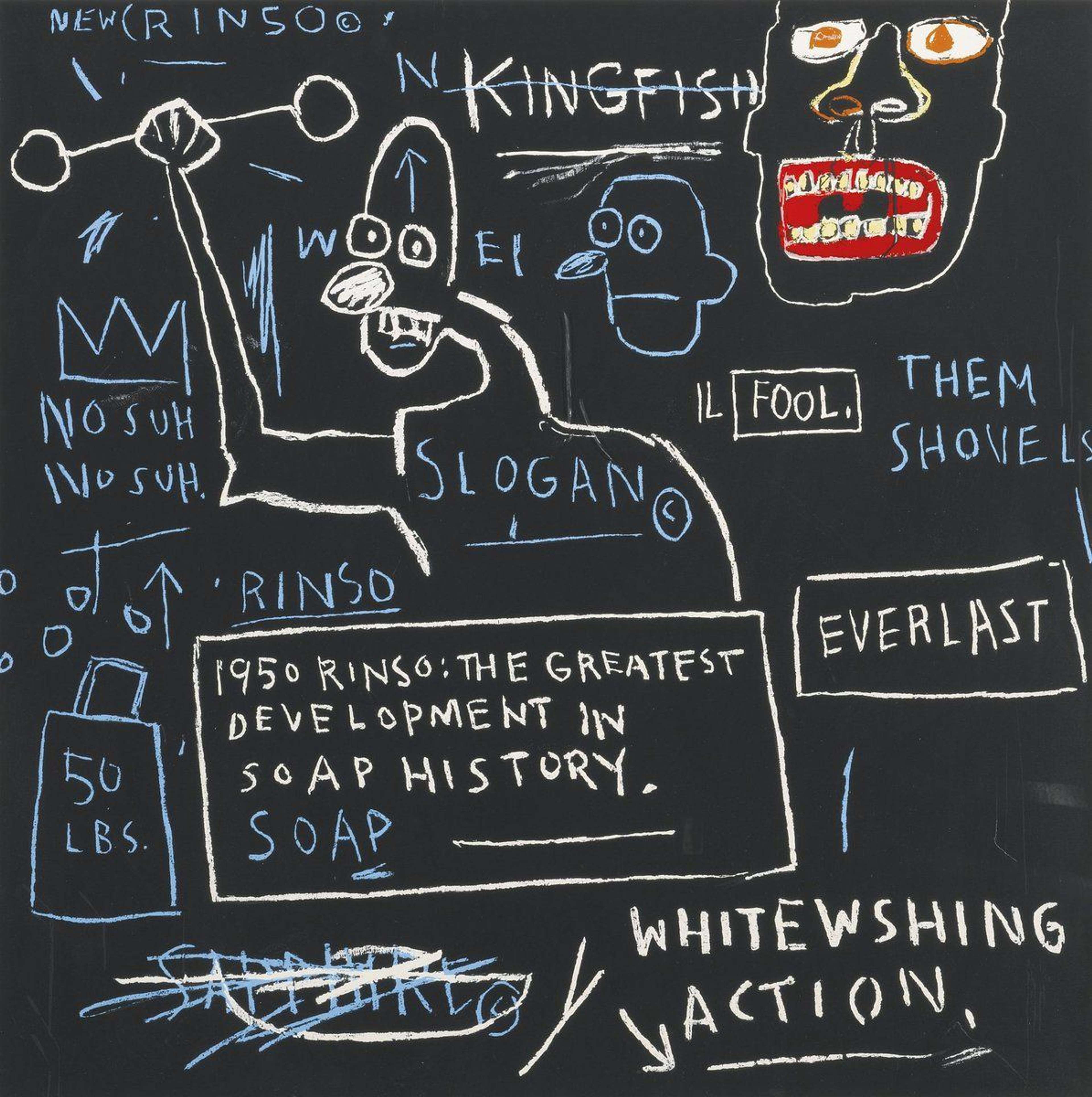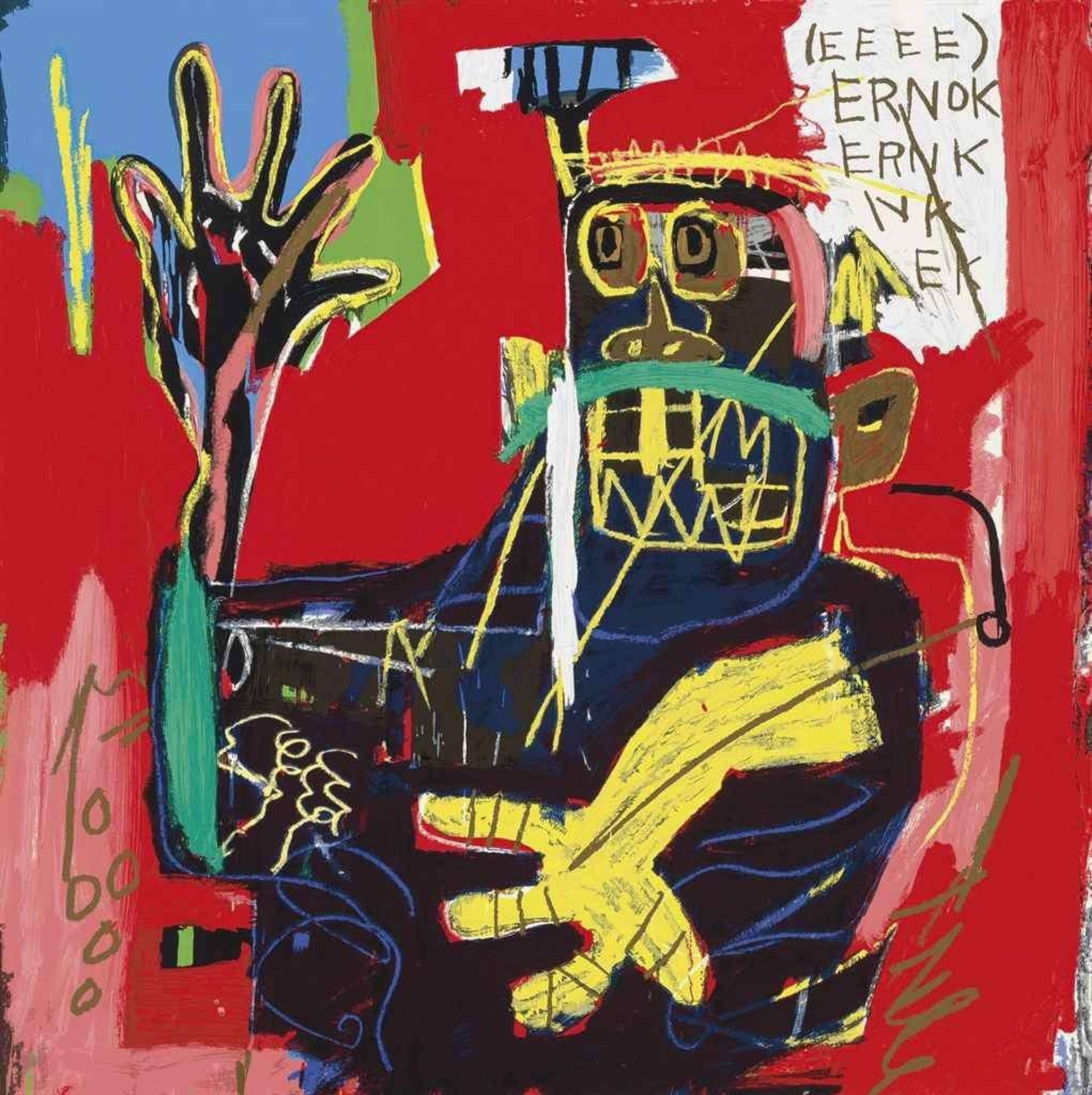 Image © Widewalls / King Zulu © Jean-Michel Basquiat 1986
Image © Widewalls / King Zulu © Jean-Michel Basquiat 1986
Interested in buying or selling
Jean-Michel Basquiat?

Jean-Michel Basquiat
57 works
Jean-Michel Basquiat, a celebrated American artist of the 1980s, rose to fame for his striking paintings that blended elements of African, Caribbean, and American culture. His art was deeply influenced by his love for jazz music, which he listened to incessantly and incorporated into his creative process. Jazz played a monumental role in Basquiat’s practice, which drew on the similarities between both art forms, inspired by key influencers of the Jazz scene.
 Image © Hyperallergic / Jean-Michel Basquiat in 1982 © James Van der Zee Archive
Image © Hyperallergic / Jean-Michel Basquiat in 1982 © James Van der Zee ArchiveThe Symbiosis of Jazz and Basquiat's Art
Jazz played a critical role in Basquiat's career, as he frequently collaborated with musicians and incorporated music into his exhibitions. Basquiat's use of jazz in his artwork was not just an artistic choice, but a reflection of his personal identity and passion for jazz. In an interview Basquiat once stated, ”I wanted to be a jazz musician, but I couldn't play anything. So I became an artist, and my paintings became my music.”
Basquiat's innovative and unique style, influenced by jazz, garnered widespread praise from collectors and critics alike, cementing his status as one of the foremost figures of the Neo-Expressionist movement. His use of jazz in his art was a testament to its significant impact on American culture and the African American experience, making him an essential voice in the art world.
 Image © Jean-Michel Basquiat / Bird On The Money © Jean-Michel Basquiat 1981
Image © Jean-Michel Basquiat / Bird On The Money © Jean-Michel Basquiat 1981Jazz Influences: Key Figures and Legends
One of the most important jazz figures for Basquiat was Charlie Parker, the pioneering saxophonist known as 'Bird'. Basquiat was drawn to Parker's innovative improvisational style, which he mirrored in his own art by improvising and spontaneously creating images on the canvas. Parker's influence can be seen in Basquiat's use of frenzied brushstrokes and repeated motifs, such as the crown and the skull.
Another jazz artist who had a significant impact on Basquiat was Dizzy Gillespie, the trumpeter who was a key figure in the development of bebop. Gillespie's complex harmonies and rhythms inspired Basquiat's use of layered text and images in his work, creating a sense of depth and complexity. Gillespie's influence can be seen in Basquiat's use of symbols and cultural references, particularly in his work exploring themes of African American identity.
Thelonious Monk, the innovative pianist and composer, was another major influence on Basquiat's art. Monk's use of dissonance, syncopation, and angular melodies can be seen in Basquiat's use of unexpected colour combinations and jagged lines. Monk's influence is particularly evident in Basquiat's later work, where he experimented with abstract forms and non-linear structures.
Charles Mingus was another influential jazz musician whose work had an impact on Basquiat's art. Mingus was known for his eclectic style, incorporating elements of blues, gospel, and classical music into his compositions. Mingus' influence on Basquiat can be seen in his use of text and language in his paintings. Like Mingus' music, Basquiat's paintings often incorporated elements of language and text, from handwritten notes and phrases to more complex layers of text and imagery. This use of text was often political in nature, addressing issues of race, class, and inequality.
 Image © Jean-Michel Basquiat / Max Roach © Jean-Michel Basquiat 1984
Image © Jean-Michel Basquiat / Max Roach © Jean-Michel Basquiat 1984Music and Text: Basquiat's Unique Integration of Jazz Lyrics
Jean-Michel Basquiat's unique integration of jazz lyrics into his artwork has become a defining characteristic of his distinctive style. In his paintings, Basquiat often incorporated text, including poetry, prose, and song lyrics, that alluded to jazz music and the cultural and political issues of his time. The fusion of visual art and music in his work served to create a powerful statement that resonated with audiences and continues to inspire artists today.
Basquiat was deeply influenced by jazz music, and his appreciation for the genre is evident in his use of lyrics in his paintings. He often referenced jazz musicians and their songs, such as Charlie Parker's Ornithology in his artwork. Basquiat's use of jazz lyrics was not simply decorative but rather played a crucial role in the meaning and interpretation of his work. By incorporating the words of jazz legends into his paintings, he linked the cultural and political significance of the music to his artistic vision, creating a dialogue between the two forms of expression.
Basquiat's unique integration of jazz lyrics into his artwork is a testament to his innovative approach to art and his ability to create a dialogue between visual art and music. The significance of his use of jazz lyrics lies in its ability to connect with audiences on an emotional and intellectual level, providing a potent statement that reflects his experiences.
 Image © Smarthistory / Horn Players © Jean-Michel Basquiat 1983
Image © Smarthistory / Horn Players © Jean-Michel Basquiat 1983The SAMO© Tag: Basquiat's Graffiti and Jazz Crossover
Jean-Michel Basquiat's iconic SAMO© tag emerged as a product of the late-1970s New York City graffiti scene. Basquiat and his friend, Al Diaz, began spraying the acronym around the city, which stood for ”Same Old Shit.“ The tag was a critical commentary on the social and political issues of the time and gained notoriety, quickly becoming a recognizable symbol of the graffiti movement
Basquiat's SAMO© tag was not only a reflection of the graffiti culture but also drew inspiration from the jazz scene of the time. Jazz's improvisational and experimental nature resonated with Basquiat and became a significant influence on his artistic style. His SAMO© tag and other graffiti works incorporated a similar improvisational approach, allowing for spontaneity and free expression in his artwork.
Basquiat's SAMO© tag intersected with jazz culture through the use of call-and-response techniques. Jazz music often features call-and-response elements, where one musician plays a melody, and another musician responds with their interpretation. Likewise, Basquiat's SAMO© tag and other graffiti works often used a call-and-response approach, where he would leave a mark or message, and other graffiti artists would respond with their own mark or message. This approach was a nod to the improvisational and collaborative nature of jazz music.
Today, the SAMO© tag remains an iconic symbol of the graffiti movement and Basquiat's enduring influence on contemporary art.
Jazz as Social Commentary: Basquiat's Art as a Critique of Inequality
Jean-Michel Basquiat's artwork is deeply rooted in his experience as a black man in America during the 1980s. His paintings often depict the harsh realities of social inequality, touching on themes of race, class, and social justice. Basquiat was influenced by jazz music and its connection to Black culture, and this can be seen in his approach to these topics. For Basquiat, jazz music was not just a form of entertainment but also a tool for social commentary.
Just as Basquiat visually narrated a glimpse into his world, so did key players in Jazz music. Charles Mingus’ Fables of Faubus was his response to the governor of Arkansas’s refusal to admit black students into a highschool. Segregation was not an uncommon topic, nor the least heinous offence against black people in this era of history. A repertoire of music including Nina Simone’s Mississippi Goddam and Strange Fruit by Billie Holiday told all too true stories of the realities of being Black in America. Unfortunately, these realities don’t come with an expiration date.
 Image © Collection of Nina Clemente / Defacement (The Death of Michael Stewart) © Jean-Michel Basquiat 1983
Image © Collection of Nina Clemente / Defacement (The Death of Michael Stewart) © Jean-Michel Basquiat 1983One of Basquiat's most famous works, Defacement The Death Of Michael Stewart, was created in response to the death of a young Black graffiti artist who was beaten to death by New York City police officers in 1983. Basquiat used his art to bring attention to police brutality and racism in America, drawing parallels between the treatment of Black people and the injustices that occurred during apartheid in South Africa.
Basquiat's Tribute to Jazz Icons: The Horn Players
Jean-Michel Basquiat's The Horn Players, completed in 1983, is a stunning example of the artist's innovative approach to painting. The work is characterised by Basquiat's blend of graffiti, text, and colour to feature his tribute to saxophonist Charlie Parker and trumpeter Dizzy Gillespie. He displays Parker on the far left and Dizzy on the right with repetitive text like “alchemy” and “Charlie Parker”. “Ornithology” is also seen multiple times as a nod to Charlie Parker, otherwise known as “Bird”.
The musicians are rendered in Basquiat's signature style, with elongated limbs, exaggerated facial features, and a sense of energetic movement. Beyond the use of text, The Horn Players also explores themes of African-American cultural heritage. The depiction of two black musicians and the use of jazz references pay tribute to the important role that this genre played in African-American cultural expression.
The Legacy of Basquiat and Jazz in Contemporary Art
In addition to inspiring individual artists, Basquiat's legacy has also influenced the way art is exhibited in galleries and museums. An immersive exhibition at the Barbican Centre in London, titled Basquiat: Boom for Real, combined art with other mediums becoming increasingly common in contemporary art.
Basquiat's influence has also spread beyond the art world, with his work referenced in pop music. Jay-Z has frequently referenced Basquiat in his lyrics and even purchased one of his paintings for $4.5 million in 2013. The crossover between jazz and hip-hop, as well as the integration of Basquiat's art into popular culture, speaks to the enduring relevance of his work.
 Image © Auralcrave / In Italian © Jean-Michel Basquiat 1983
Image © Auralcrave / In Italian © Jean-Michel Basquiat 1983The Enduring Impact of Jazz on Jean-Michel Basquiat's Art
It is important to understand jazz's role in Basquiat's art for a deeper appreciation of his work, giving insight into the complexity and depth of his creative process, and the ways in which he drew from various sources of inspiration to create his unique vision. The intersections between different art forms are fertile ground for exploration, and can lead to a richer understanding of art and culture. Basquiat's work serves as a testament to the transformative power of art, and the ways in which it can bridge cultural divides and bring people together.






